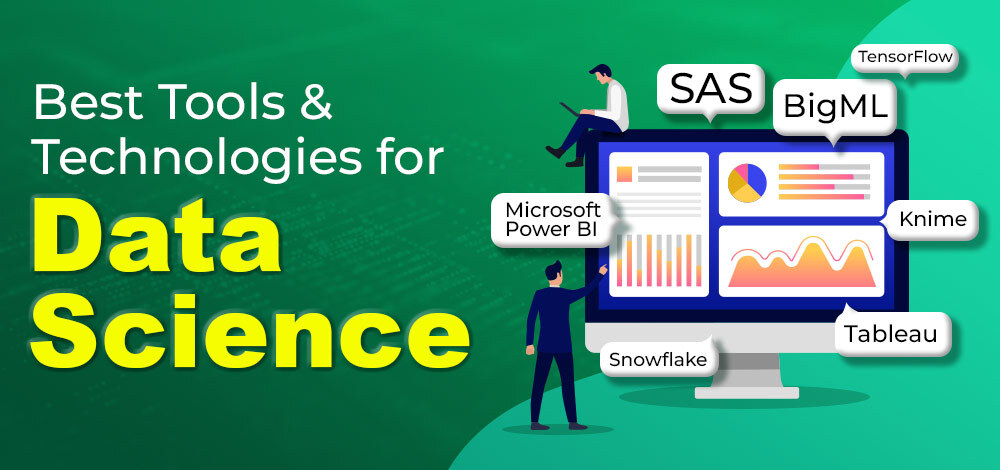Data Science has been playing a vital role in almost every industry today whether you call it for taking business decisions or planning or future forecasting. It all falls under the technology and trends that we’re going forward with. We’re running in 2022, a world full of the digital era, and we’ve got numbers of data all over and we are using different tools and techniques to make resourceful for different purposes. If you’d talk about any popular technology, it would be “Data Science” only.
To perform certain activities requires an individual to have proficiency in any of the programming languages (from a certain list) and various tools too. Even if you’ll dig in, there are more than 38,000 jobs available as of today alone in India and approx 5,24,000 worldwide. These figures suggest that the demand for data science experts is increasing every day in almost every sector and that’s why it is mandated to keep yourself updated with the latest tools and technologies. We thought to bring attention to data science and provide you with a list of 7 hand-picked best tools and technologies that are being used in data science.
1. SAS
Within Data science, there are certain categories from which “data visualization” is also one of them. When you’re working with visualization, SAS is the name of a tool that should come first in the “statistical” category. It is being used to create and present a symmetric chart of analytics and helps in managing data. For that, it uses the SAS programming language to outcast statistical modeling. If you’re into this field or trying to get into data science, we recommend you learn this tool because most of the companies are working on relatable metrics and would require you to be familiar with these kinds of tools. Having a basic understanding of data science is what you require to become proficient in these tools and technologies. You might consider joining Compelete Data Science Program – Live Course where you’ll be guided with everything to prepare you for a job-ready professional.
Besides the fact that being one of the most expensive software in the industry, only companies of large-cap size would require you to have knowledge of this tool and it provides a list of features that will help you in deciding its application within your work, some of them are:
- Location Analytics
- Text Analytics
- Business Intelligence
- Augmented Analytics
2. Microsoft Power BI
The most powerful tool that you should definitely know while working on data visualization. Being a cloud-based analysis service, it offers to provide insight into any given data that helps in taking business decisions. It has the capability to provide an extensive analytical environment for monitoring reports from different aspects. The primary reason for its being a preference for data scientists is none other than “Ease of Usage”, and that makes it more approachable for people to apply them for data visualization.
This software is packed with some of the most appealing templates that you can use in your project including the following methods:
- Box plotting
- Scatter Plotting
- Distribution plotting
- Real-time information
- Power Map
- Power View
3. BigML
Another specialized tool that is being used in the field of data science for predictive modeling is capable of applying methods that include ML algorithms like data clustering, classification, anomaly detection, time-series forecasting, etc. Besides this, it also offers an interactable, cloud-based GUI environment that can be used for sales forecasting, analyzing risks, and product innovation. Today, more than 1,50,000 users are actively using BigML, and have a strong community base from all around the world. Even the best thing about BigML is that it allows users to create their private dashboard and when all details are pulled via its API, they provide enhanced security by allowing HTTPS for smooth flow of data and communication. Below are some of the following noticeable features that you might be aware of:
- Cluster analysis: FOr discovery, anomaly detection, etc.
- Backup ML models: for data visualization
- ML algorithm: Enables processing within your project
4. Knime
Abbreviated as Konstanz Information Miner, is an open-source tool that is designed for data analysis, written in Java, and built on Eclipse. It also offers the concept of a modular data pipeline that allows people to do data mining. Perhaps this tool is designed for data analysis and one should have a basic concept of the same, in case, you want to learn in-depth Data Analysis, then consider this enhanced course, crafted for beginners – Data Analysis with Python- Self-Paced.
Besides this, data modeling, data preprocessing, visualization, etc. are also offered by KNIME. It also includes filtration, conversion, and a combination of data sets that have been consistently used in data science and that’s what makes it among the best data science tools that you must know.
5. Tableau
Since we’re talking about data science popular tools, then how can we skip tableau. One of the most popular and possibly widely used tools for data visualization in Tableau. This tool is well built to cater to both data science and business intelligence. Due to its simplicity, it helps to create simple yet elegant data that are easy to understand by professionals at any level (both tech and non-tech), and also offers non-tech people to create their customizable dashboards. These factors make it more appealing for data science professionals to implement this tool in their projects.
Since these tools require you to have a solid grip on Python, we recommend you learn Python from scratch – Python Programming Foundation – Self-Paced.
6. TensorFlow
You might have heard of “TensorFlow” as this tool is being widely used among professionals and data scientists. Being an open-source platform, it allows user to create data flow graphs where nodes in the graph significantly represent a mathematical and statistical operation, and the graph, on the other hand, represent multidimensional arrays (data) that flow among them. This mechanism allows ML to visualize as a graph of operations (connected ones). Besides this, they’re built to execute on various platforms aligning GPU, CPU, and TPU without having to write code again and again which eventually means that it’s open for all and anybody can use this tool to boost efficiency. Besides this, it also allows users to monitor the process (training), along with all the metrics for evaluation.
7. Snowflake
“Data Warehousing” is one of the most important subsidiaries in Data Science today and the best tool to perform this action is the snowflake that’s built on SQL for the cloud. The best part about this is it offers free hands in flexibility and efficiency which is not that easy without any big data platform. Besides this, it also offers some other benefits that make it more reliable for using it as a data warehousing tool, some of them are:
- The data cannot be accessed by anyone that’s stored within it, in fact, it will require the user to access it via SQL query using snowflake to view the stored data.
- It builds all of its resources to create a virtual warehouse that is able to secure and process it even more fluently. This makes it to replicate the data across the cloud when and if there’s any failure (to ensure a smooth business run).
- A user can access only a limited data as they’ll pay which means every time they want to access the data (or any portion) they’ll have to pay a certain amount to do that.





